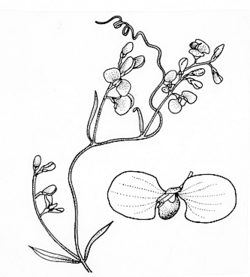
Description: Slender shrubs or twiners.
Leaves alternate, often caducous or reduced to scales.
Flowers in single or clustered terminal racemes, occasionally in axillary racemes or solitary, each subtended by a caducous bract and bracteoles at base. Sepals 5, unequal, 2 inner sepals large and wing-like ± petaloid. Petals 3, or 5 with 2 reduced or vestigial, lower two petals ± united to form a keel or usually lobed or pouched. Stamens 8, fused with petals for about half their length, and either diadelphous and sessile, or free; anthers opening by apical pores. Ovary 2-locular, laterally compressed; style flattened and bent below a broad, truncate, 2-lobed or bifurcate apex with stigma on one side.
Fruit a compressed cuneate capsule with a narrow marginal wing; seeds with hairs lengthening into a coma.
Distribution and occurrence: World: 24 species, endemic Australia. Australia: all States.
Text by L. Murray
Taxon concept:
Taxa not yet included in identification key
Comesperma breviflorum
| | Key to the species | |
| 1 | Leafy erect plants; stamens diadelphous above middle | 2 |
| Sparsely-leaved plants, often climbing or lax; stamens free above the middle | 4 |
| 2 | Leaves with margins recurved to revolute, rarely flat but then lower surface pale-coloured with midvein conspicuous | Comesperma ericinum |
| Leaves flat or slightly keeled
Back to 1 | 3 |
| 3 | Leaves with apex acute or obtuse, mucronate; outer sepals a quarter as long as the wing sepals | Comesperma sylvestre |
| Leaves usually obtuse, not mucronate; outer sepals about half as long as the wing sepals
Back to 2 | Comesperma retusum |
| 4 | Stems twining | 5 |
| Stems stiff or lax but not twining
Back to 1 | 6 |
| 5 | Inflorescences axillary, pedicel and calyx usually glabrous | Comesperma volubile |
| Inflorescences terminal on short branches, pedicel with short appressed hairs, calyx ciliate
Back to 4 | Comesperma integerrimum |
| 6 | Outer sepals c. 1 mm long, wing sepals mostly 2–3 mm long; fruit long-attenuate at base | Comesperma defoliatum |
| Outer sepals c. 3 mm long, wing sepals mostly c. 6 mm long; fruit not long-attenuate at base
Back to 4 | Comesperma sphaerocarpum |
|


